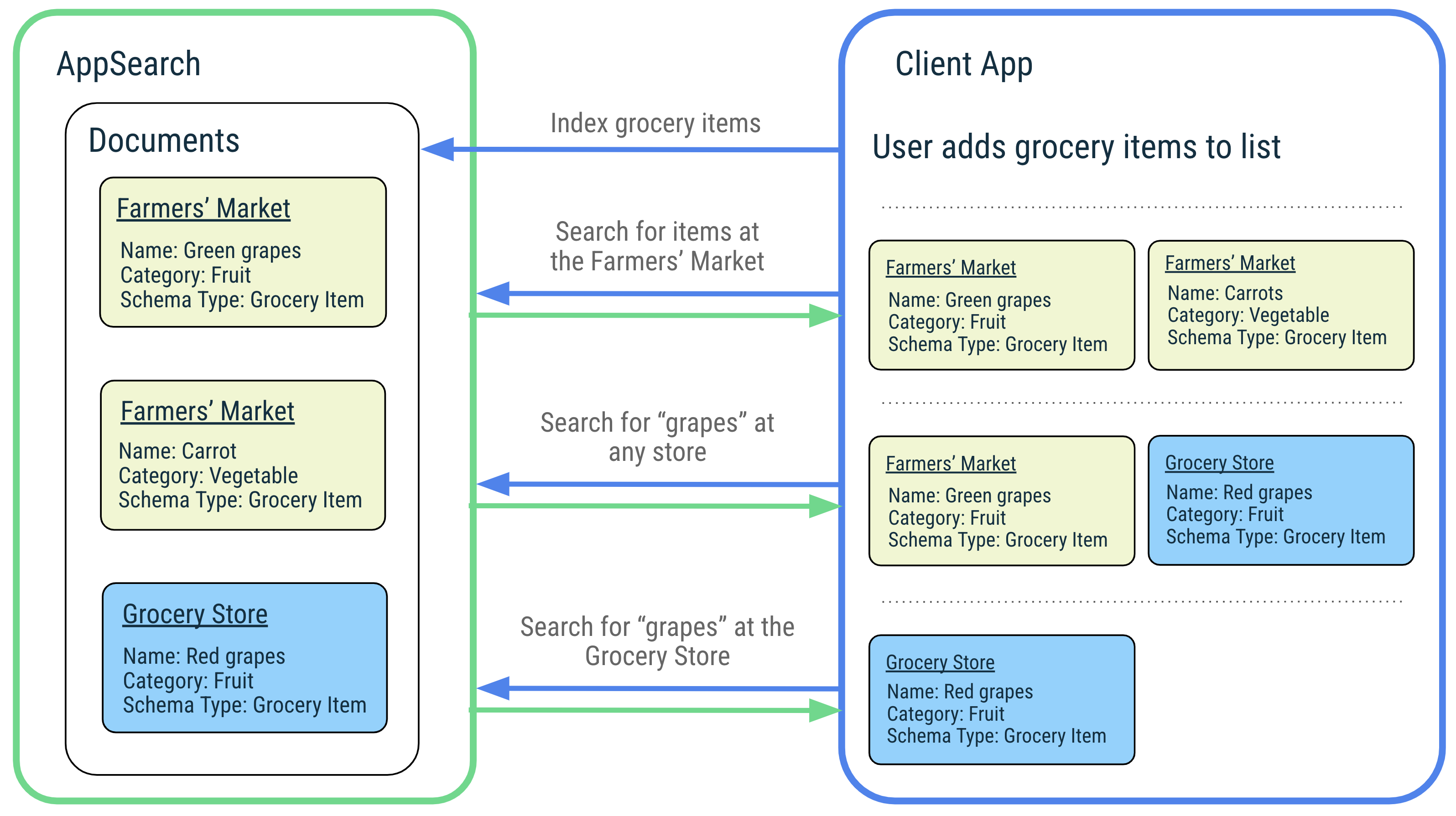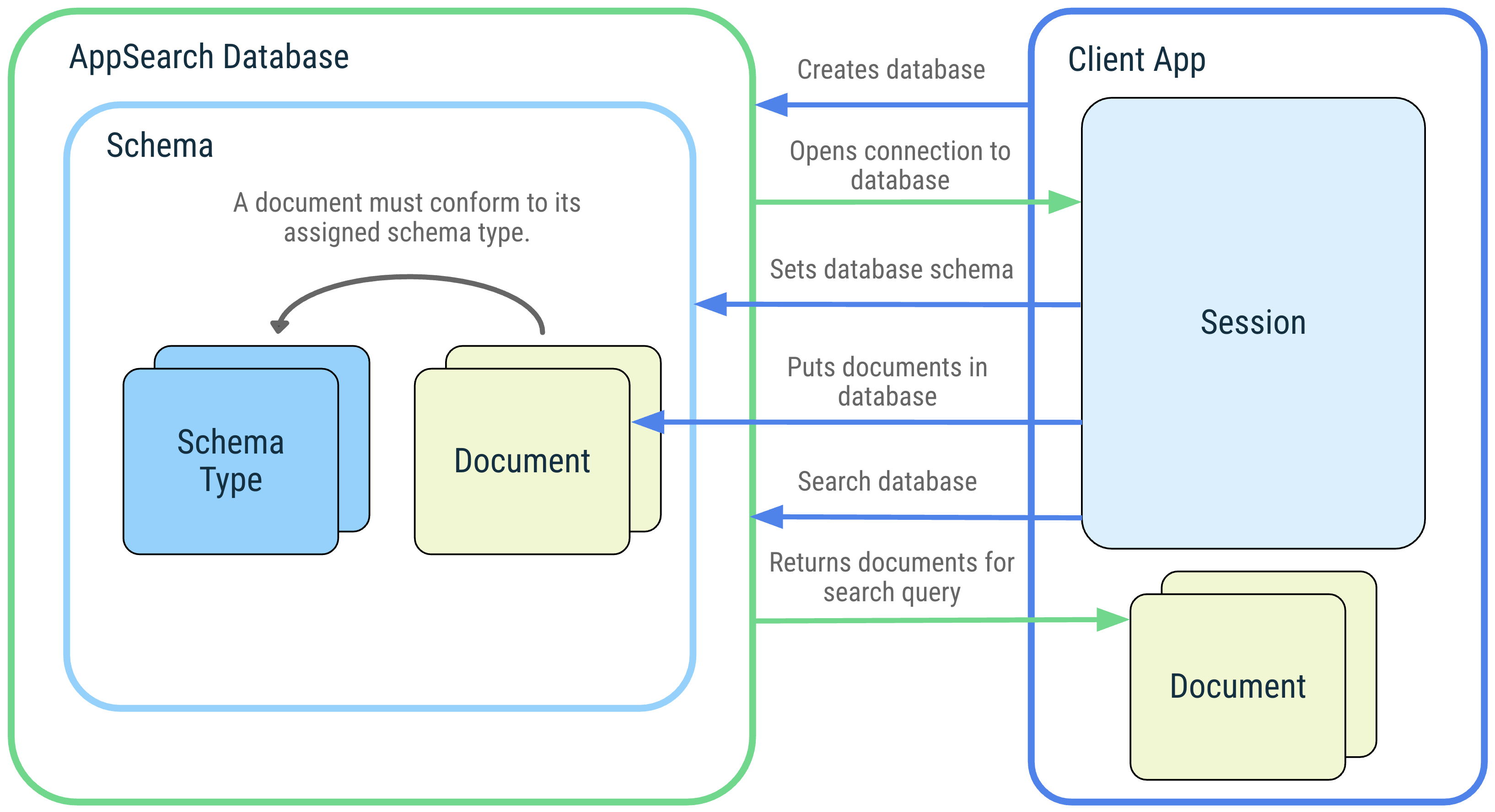AppSearch เป็นโซลูชันการค้นหาในอุปกรณ์ที่มีประสิทธิภาพสูงสำหรับจัดการ Structured Data ที่เก็บไว้ในเครื่อง ซึ่งประกอบด้วย API สําหรับการจัดทําดัชนีและการดึงข้อมูลโดยใช้การค้นหาข้อความแบบเต็ม แอปพลิเคชันสามารถใช้ AppSearch เพื่อมอบความสามารถในการค้นหาในแอปที่กําหนดเอง ซึ่งช่วยให้ผู้ใช้ค้นหาเนื้อหาได้แม้จะออฟไลน์อยู่

AppSearch มีฟีเจอร์ต่อไปนี้
- การติดตั้งใช้งานพื้นที่เก็บข้อมูลที่รวดเร็วและเน้นอุปกรณ์เคลื่อนที่เป็นหลักโดยใช้ I/O ต่ำ
- การจัดทำดัชนีและการค้นหาชุดข้อมูลขนาดใหญ่ที่มีประสิทธิภาพสูง
- รองรับหลายภาษา เช่น อังกฤษและสเปน
- การจัดอันดับความเกี่ยวข้องและการให้คะแนนการใช้งาน
AppSearch ใช้เวลาในการตอบสนองในการจัดทำดัชนีและการค้นหาชุดข้อมูลขนาดใหญ่ต่ำกว่า SQLite เนื่องจากมีการใช้ I/O น้อยกว่า AppSearch ลดความซับซ้อนในการค้นหาข้ามประเภทด้วยการรองรับการค้นหารายการเดียว ขณะที่ SQLite จะผสานผลการค้นหาจากหลายตาราง
มาดูตัวอย่างฟีเจอร์ของ AppSearch กันด้วยแอปพลิเคชันเพลงที่จัดการเพลงโปรดของผู้ใช้และช่วยให้ผู้ใช้ค้นหาเพลงเหล่านั้นได้อย่างง่ายดาย ผู้ใช้สามารถฟังเพลงจากทั่วโลกที่มีชื่อเพลงเป็นภาษาต่างๆ ซึ่ง AppSearch รองรับการจัดทำดัชนีและการค้นหาโดยกำเนิด เมื่อผู้ใช้ค้นหาเพลงตามชื่อหรือชื่อศิลปิน แอปพลิเคชันจะส่งคำขอไปยัง AppSearch เพื่อดึงข้อมูลเพลงที่ตรงกันอย่างรวดเร็วและมีประสิทธิภาพ แอปพลิเคชันจะแสดงผลลัพธ์ ซึ่งช่วยให้ผู้ใช้เริ่มเล่นเพลงโปรดได้อย่างรวดเร็ว
ตั้งค่า
หากต้องการใช้ AppSearch ในแอปพลิเคชัน ให้เพิ่มทรัพยากร Dependency ต่อไปนี้ลงในไฟล์ build.gradle ของแอปพลิเคชัน
Groovy
dependencies { def appsearch_version = "1.1.0" implementation "androidx.appsearch:appsearch:$appsearch_version" // Use kapt instead of annotationProcessor if writing Kotlin classes annotationProcessor "androidx.appsearch:appsearch-compiler:$appsearch_version" implementation "androidx.appsearch:appsearch-local-storage:$appsearch_version" // PlatformStorage is compatible with Android 12+ devices, and offers additional features // to LocalStorage. implementation "androidx.appsearch:appsearch-platform-storage:$appsearch_version" // PlayServicesStorage is compatible with all devices that support Google Play Services on // all API levels. It offers the same features as PlatformStorage and is the recommended // solution for lower API levels on which PlatformStorage is not supported. implementation "androidx.appsearch:appsearch-play-services-storage:$appsearch_version" }
Kotlin
dependencies { val appsearch_version = "1.1.0" implementation("androidx.appsearch:appsearch:$appsearch_version") // Use annotationProcessor instead of kapt if writing Java classes kapt("androidx.appsearch:appsearch-compiler:$appsearch_version") implementation("androidx.appsearch:appsearch-local-storage:$appsearch_version") // PlatformStorage is compatible with Android 12+ devices, and offers additional features // to LocalStorage. implementation("androidx.appsearch:appsearch-platform-storage:$appsearch_version") // PlayServicesStorage is compatible with all devices that support Google Play Services on // all API levels. It offers the same features as PlatformStorage and is the recommended // solution for lower API levels on which PlatformStorage is not supported. implementation("androidx.appsearch:appsearch-play-services-storage:$appsearch_version") }
แนวคิดเกี่ยวกับ AppSearch
แผนภาพต่อไปนี้แสดงแนวคิดของ AppSearch และการโต้ตอบ
 รูปที่ 1 แผนภาพแนวคิดของ AppSearch: ฐานข้อมูล AppSearch, สคีมา, ประเภทสคีมา, เอกสาร, เซสชัน และการค้นหา
รูปที่ 1 แผนภาพแนวคิดของ AppSearch: ฐานข้อมูล AppSearch, สคีมา, ประเภทสคีมา, เอกสาร, เซสชัน และการค้นหา
ฐานข้อมูลและเซสชัน
ฐานข้อมูล AppSearch คือคอลเล็กชันเอกสารที่เป็นไปตามสคีมาฐานข้อมูล แอปพลิเคชันไคลเอ็นต์สร้างฐานข้อมูลโดยระบุบริบทของแอปพลิเคชันและชื่อฐานข้อมูล มีเพียงแอปพลิเคชันที่สร้างขึ้นเท่านั้นที่เปิดฐานข้อมูลได้ เมื่อเปิดฐานข้อมูล ระบบจะแสดงเซสชันเพื่อโต้ตอบกับฐานข้อมูล เซสชันคือจุดแรกเข้าสำหรับการเรียกใช้ AppSearch API และจะยังคงเปิดอยู่จนกว่าแอปพลิเคชันไคลเอ็นต์จะปิด
สคีมาและประเภทสคีมา
สคีมาแสดงโครงสร้างองค์กรของข้อมูลภายในฐานข้อมูล AppSearch
สคีมาประกอบด้วยประเภทสคีมาที่แสดงถึงประเภทข้อมูลที่ไม่ซ้ำกัน ประเภทสคีมาประกอบด้วยพร็อพเพอร์ตี้ที่มีชื่อ ประเภทข้อมูล และ Cardinality เมื่อเพิ่มสคีมาประเภทหนึ่งลงในสคีมาฐานข้อมูลแล้ว คุณสามารถสร้างและเพิ่มเอกสารประเภทสคีมานั้นลงในฐานข้อมูลได้
เอกสาร
ใน AppSearch หน่วยข้อมูลจะแสดงเป็นเอกสาร เอกสารแต่ละรายการในฐานข้อมูล AppSearch จะระบุด้วยเนมสเปซและรหัสที่ไม่ซ้ำกัน เนมสเปซใช้เพื่อแยกข้อมูลจากแหล่งที่มาต่างๆ เมื่อต้องการค้นหาแหล่งที่มาเพียงแหล่งเดียว เช่น บัญชีผู้ใช้
เอกสารมีการประทับเวลาสร้าง, Time to Live (TTL) และคะแนนที่ใช้ในการจัดอันดับระหว่างการเรียกข้อมูล นอกจากนี้ ระบบจะกำหนดประเภทสคีมาให้กับเอกสาร ซึ่งอธิบายพร็อพเพอร์ตี้ข้อมูลเพิ่มเติมที่เอกสารต้องมี
คลาสเอกสารเป็นการแยกแยะเอกสาร ซึ่งมีช่องที่มีคำอธิบายประกอบซึ่งแสดงถึงเนื้อหาของเอกสาร โดยค่าเริ่มต้น ชื่อของคลาสเอกสารจะเป็นชื่อของประเภทสคีมา
ค้นหา
ระบบจะจัดทําดัชนีเอกสารและค้นหาได้โดยระบุข้อความค้นหา ระบบจะจับคู่และรวมเอกสารไว้ในผลการค้นหาหากเอกสารมีคำในคำค้นหาหรือตรงกับข้อกำหนดการค้นหาอื่น ผลการค้นหาจะเรียงลําดับตามคะแนนและกลยุทธ์การจัดอันดับ ผลการค้นหาจะแสดงเป็นหน้าเว็บที่คุณเรียกดูได้ทีละหน้า
AppSearch มีการปรับแต่งการค้นหา เช่น ตัวกรอง การกำหนดค่าขนาดหน้าเว็บ และการตัดข้อมูล
พื้นที่เก็บข้อมูลแพลตฟอร์ม พื้นที่เก็บข้อมูลในเครื่อง หรือพื้นที่เก็บข้อมูลบริการ Play
AppSearch มีโซลูชันพื้นที่เก็บข้อมูล 3 รายการ ได้แก่ LocalStorage, PlatformStorage และ
PlayServicesStorage เมื่อใช้ LocalStorage แอปพลิเคชันจะจัดการดัชนีเฉพาะแอปที่อยู่ในไดเรกทอรีข้อมูลแอปพลิเคชัน เมื่อใช้ทั้ง PlatformStorage และ PlayServicesStorage แอปพลิเคชันของคุณจะมีส่วนร่วมในดัชนีกลางทั่วทั้งระบบ ดัชนีของ PlatformStorage โฮสต์อยู่ในเซิร์ฟเวอร์ของระบบ และดัชนีของ PlayServicesStorage โฮสต์อยู่ในพื้นที่เก็บข้อมูลของบริการ Google Play การเข้าถึงข้อมูลภายในดัชนีกลางเหล่านี้จํากัดไว้เฉพาะข้อมูลที่แอปพลิเคชันของคุณให้ไว้และข้อมูลที่แอปพลิเคชันอื่นแชร์กับคุณอย่างชัดเจน ตัวเลือกพื้นที่เก็บข้อมูลทั้งหมดเหล่านี้ใช้ API เดียวกันและสามารถใช้แทนกันได้โดยขึ้นอยู่กับเวอร์ชันของอุปกรณ์
Kotlin
if (BuildCompat.isAtLeastS()) { appSearchSessionFuture.setFuture( PlatformStorage.createSearchSession( PlatformStorage.SearchContext.Builder(mContext, DATABASE_NAME) .build() ) ) } else { if (usePlayServicesStorageBelowS) { appSearchSessionFuture.setFuture( PlayServicesStorage.createSearchSession( PlayServicesStorage.SearchContext.Builder(mContext, DATABASE_NAME) .build() ) ) } else { appSearchSessionFuture.setFuture( LocalStorage.createSearchSession( LocalStorage.SearchContext.Builder(mContext, DATABASE_NAME) .build() ) ) } }
Java
if (BuildCompat.isAtLeastS()) { mAppSearchSessionFuture.setFuture(PlatformStorage.createSearchSession( new PlatformStorage.SearchContext.Builder(mContext, DATABASE_NAME) .build())); } else { if (usePlayServicesStorageBelowS) { mAppSearchSessionFuture.setFuture(PlayServicesStorage.createSearchSession( new PlayServicesStorage.SearchContext.Builder(mContext, DATABASE_NAME) .build())); } else { mAppSearchSessionFuture.setFuture(LocalStorage.createSearchSession( new LocalStorage.SearchContext.Builder(mContext, DATABASE_NAME) .build())); } }
เมื่อใช้ PlatformStorage และ PlayServicesStorage แอปพลิเคชันของคุณจะสามารถแชร์ข้อมูลกับแอปพลิเคชันอื่นๆ อย่างปลอดภัยเพื่อให้แอปพลิเคชันเหล่านั้นค้นหาข้อมูลของแอปคุณได้ด้วย การแชร์ข้อมูลแอปพลิเคชันแบบอ่านอย่างเดียวจะได้รับการอนุญาตโดยใช้การจับมือด้วยใบรับรองเพื่อให้มั่นใจว่าแอปพลิเคชันอื่นมีสิทธิ์อ่านข้อมูล อ่านข้อมูลเพิ่มเติมเกี่ยวกับ API นี้ในเอกสารประกอบสำหรับ setSchemaTypeVisibilityForPackage()
นอกจากนี้ PlatformStorage ยังช่วยให้ข้อมูลที่จัดทำดัชนีแสดงในแพลตฟอร์ม UI ของระบบได้ แอปพลิเคชันสามารถเลือกไม่ใช้การแสดงข้อมูลบางส่วนหรือทั้งหมดบนแพลตฟอร์ม UI ของระบบ อ่านข้อมูลเพิ่มเติมเกี่ยวกับ API นี้ในเอกสารประกอบของ setSchemaTypeDisplayedBySystem()
| ฟีเจอร์ | LocalStorage (ใช้ได้กับ Android 5.0 ขึ้นไป) |
PlatformStorage (ใช้ได้กับ Android 12 ขึ้นไป) |
PlayServicesStorage (ใช้ได้กับ Android 5.0 ขึ้นไป) |
|---|---|---|---|
| การค้นหาข้อความแบบเต็มอย่างมีประสิทธิภาพ | |||
| การรองรับหลายภาษา | |||
| ไฟล์ไบนารีมีขนาดเล็กลง | |||
| การแชร์ข้อมูลระหว่างแอปพลิเคชัน | |||
| ความสามารถในการแสดงข้อมูลบนแพลตฟอร์ม UI ของระบบ | |||
| จัดทำดัชนีเอกสารได้ไม่จำกัดจำนวนและขนาด | |||
| การดำเนินการที่เร็วขึ้นโดยไม่มีเวลาในการตอบสนองเพิ่มเติมของ Binder |
มีข้อควรพิจารณาเพิ่มเติมที่ควรพิจารณาเมื่อเลือกระหว่าง LocalStorage
กับ PlatformStorage เนื่องจาก PlatformStorage แพ็กเกจ API ของ Jetpack ไว้ในบริการระบบ AppSearch ผลกระทบต่อขนาด APK จึงมีน้อยมากเมื่อเทียบกับการใช้ LocalStorage อย่างไรก็ตาม การดำเนินการของ AppSearch จะเกิดความล่าช้าเพิ่มเติมของ Binder เมื่อเรียกใช้บริการระบบ AppSearch ด้วย เมื่อใช้ PlatformStorage
AppSearch จะจำกัดจำนวนเอกสารและขนาดของเอกสารที่แอปพลิเคชันจัดทำดัชนีได้ เพื่อให้ได้ดัชนีกลางที่มีประสิทธิภาพ PlayServicesStorage มีข้อจำกัดเช่นเดียวกับ PlatformStorage และใช้ได้เฉพาะในอุปกรณ์ที่มีบริการ Google Play
เริ่มต้นใช้งาน AppSearch
ตัวอย่างในส่วนนี้แสดงวิธีใช้ AppSearch API เพื่อผสานรวมกับแอปพลิเคชันการจดบันทึกสมมติ
เขียนคลาสเอกสาร
ขั้นตอนแรกในการผสานรวมกับ AppSearch คือเขียนคลาสเอกสารเพื่ออธิบายข้อมูลที่จะใช้แทรกลงในฐานข้อมูล ทำเครื่องหมายคลาสเป็นคลาสเอกสารโดยใช้คำอธิบายประกอบ @Document คุณสามารถใช้อินสแตนซ์ของคลาสเอกสารเพื่อใส่เอกสารและดึงเอกสารจากฐานข้อมูลได้
โค้ดต่อไปนี้กำหนดคลาสเอกสารโน้ตที่มีช่องที่มีคำอธิบายประกอบ @Document.StringProperty สำหรับจัดทำดัชนีข้อความของออบเจ็กต์โน้ต
Kotlin
@Document public data class Note( // Required field for a document class. All documents MUST have a namespace. @Document.Namespace val namespace: String, // Required field for a document class. All documents MUST have an Id. @Document.Id val id: String, // Optional field for a document class, used to set the score of the // document. If this is not included in a document class, the score is set // to a default of 0. @Document.Score val score: Int, // Optional field for a document class, used to index a note's text for this // document class. @Document.StringProperty(indexingType = AppSearchSchema.StringPropertyConfig.INDEXING_TYPE_PREFIXES) val text: String )
Java
@Document public class Note { // Required field for a document class. All documents MUST have a namespace. @Document.Namespace private final String namespace; // Required field for a document class. All documents MUST have an Id. @Document.Id private final String id; // Optional field for a document class, used to set the score of the // document. If this is not included in a document class, the score is set // to a default of 0. @Document.Score private final int score; // Optional field for a document class, used to index a note's text for this // document class. @Document.StringProperty(indexingType = StringPropertyConfig.INDEXING_TYPE_PREFIXES) private final String text; Note(@NonNull String id, @NonNull String namespace, int score, @NonNull String text) { this.id = Objects.requireNonNull(id); this.namespace = Objects.requireNonNull(namespace); this.score = score; this.text = Objects.requireNonNull(text); } @NonNull public String getNamespace() { return namespace; } @NonNull public String getId() { return id; } public int getScore() { return score; } @NonNull public String getText() { return text; } }
เปิดฐานข้อมูล
คุณต้องสร้างฐานข้อมูลก่อนจึงจะทำงานกับเอกสารได้ โค้ดต่อไปนี้จะสร้างฐานข้อมูลใหม่ชื่อ notes_app และรับ ListenableFuture สำหรับ AppSearchSession ซึ่งแสดงการเชื่อมต่อกับฐานข้อมูลและให้บริการ API สําหรับการดําเนินการกับฐานข้อมูล
Kotlin
val context: Context = getApplicationContext() val sessionFuture = LocalStorage.createSearchSession( LocalStorage.SearchContext.Builder(context, /*databaseName=*/"notes_app") .build() )
Java
Context context = getApplicationContext(); ListenableFuture<AppSearchSession> sessionFuture = LocalStorage.createSearchSession( new LocalStorage.SearchContext.Builder(context, /*databaseName=*/ "notes_app") .build() );
ตั้งค่าสคีมา
คุณต้องตั้งค่าสคีมาก่อนจึงจะใส่เอกสารและเรียกข้อมูลเอกสารจากฐานข้อมูลได้ สคีมาฐานข้อมูลประกอบด้วย Structured Data ประเภทต่างๆ ซึ่งเรียกว่า "ประเภทสคีมา" โค้ดต่อไปนี้จะตั้งค่าสคีมาโดยระบุคลาสเอกสารเป็นประเภทสคีมา
Kotlin
val setSchemaRequest = SetSchemaRequest.Builder().addDocumentClasses(Note::class.java) .build() val setSchemaFuture = Futures.transformAsync( sessionFuture, { session -> session?.setSchema(setSchemaRequest) }, mExecutor )
Java
SetSchemaRequest setSchemaRequest = new SetSchemaRequest.Builder().addDocumentClasses(Note.class) .build(); ListenableFuture<SetSchemaResponse> setSchemaFuture = Futures.transformAsync(sessionFuture, session -> session.setSchema(setSchemaRequest), mExecutor);
ใส่เอกสารในฐานข้อมูล
เมื่อเพิ่มสคีมาประเภทหนึ่งแล้ว คุณจะเพิ่มเอกสารประเภทนั้นลงในฐานข้อมูลได้
โค้ดต่อไปนี้จะสร้างเอกสารประเภทสคีมา Note โดยใช้เครื่องมือสร้างคลาสเอกสาร Note
ซึ่งจะตั้งค่าเนมสเปซเอกสาร user1 เพื่อแสดงผู้ใช้แบบสุ่มของตัวอย่างนี้ จากนั้นระบบจะแทรกเอกสารลงในฐานข้อมูลและแนบ Listener เพื่อประมวลผลผลลัพธ์ของการดำเนินการ Put
Kotlin
val note = Note( namespace="user1", id="noteId", score=10, text="Buy fresh fruit" ) val putRequest = PutDocumentsRequest.Builder().addDocuments(note).build() val putFuture = Futures.transformAsync( sessionFuture, { session -> session?.put(putRequest) }, mExecutor ) Futures.addCallback( putFuture, object : FutureCallback<AppSearchBatchResult<String, Void>?> { override fun onSuccess(result: AppSearchBatchResult<String, Void>?) { // Gets map of successful results from Id to Void val successfulResults = result?.successes // Gets map of failed results from Id to AppSearchResult val failedResults = result?.failures } override fun onFailure(t: Throwable) { Log.e(TAG, "Failed to put documents.", t) } }, mExecutor )
Java
Note note = new Note(/*namespace=*/"user1", /*id=*/ "noteId", /*score=*/ 10, /*text=*/ "Buy fresh fruit!"); PutDocumentsRequest putRequest = new PutDocumentsRequest.Builder().addDocuments(note) .build(); ListenableFuture<AppSearchBatchResult<String, Void>> putFuture = Futures.transformAsync(sessionFuture, session -> session.put(putRequest), mExecutor); Futures.addCallback(putFuture, new FutureCallback<AppSearchBatchResult<String, Void>>() { @Override public void onSuccess(@Nullable AppSearchBatchResult<String, Void> result) { // Gets map of successful results from Id to Void Map<String, Void> successfulResults = result.getSuccesses(); // Gets map of failed results from Id to AppSearchResult Map<String, AppSearchResult<Void>> failedResults = result.getFailures(); } @Override public void onFailure(@NonNull Throwable t) { Log.e(TAG, "Failed to put documents.", t); } }, mExecutor);
ค้นหา
คุณสามารถค้นหาเอกสารที่จัดทําดัชนีโดยใช้การดำเนินการค้นหาที่กล่าวถึงในส่วนนี้ได้ โค้ดต่อไปนี้จะค้นหาคำว่า "fruit" ในฐานข้อมูลสำหรับเอกสารที่เป็นของเนมสเปซ user1
Kotlin
val searchSpec = SearchSpec.Builder() .addFilterNamespaces("user1") .build(); val searchFuture = Futures.transform( sessionFuture, { session -> session?.search("fruit", searchSpec) }, mExecutor ) Futures.addCallback( searchFuture, object : FutureCallback<SearchResults> { override fun onSuccess(searchResults: SearchResults?) { iterateSearchResults(searchResults) } override fun onFailure(t: Throwable?) { Log.e("TAG", "Failed to search notes in AppSearch.", t) } }, mExecutor )
Java
SearchSpec searchSpec = new SearchSpec.Builder() .addFilterNamespaces("user1") .build(); ListenableFuture<SearchResults> searchFuture = Futures.transform(sessionFuture, session -> session.search("fruit", searchSpec), mExecutor); Futures.addCallback(searchFuture, new FutureCallback<SearchResults>() { @Override public void onSuccess(@Nullable SearchResults searchResults) { iterateSearchResults(searchResults); } @Override public void onFailure(@NonNull Throwable t) { Log.e(TAG, "Failed to search notes in AppSearch.", t); } }, mExecutor);
วนผ่าน SearchResults
การค้นหาจะแสดงอินสแตนซ์ SearchResults ซึ่งให้สิทธิ์เข้าถึงหน้าออบเจ็กต์ SearchResult SearchResult แต่ละรายการจะเก็บ GenericDocument ที่ตรงกัน ซึ่งเป็นรูปแบบทั่วไปของเอกสารที่ระบบจะแปลงเอกสารทั้งหมดเป็น โค้ดต่อไปนี้จะรับหน้าแรกของผลการค้นหาและแปลงผลลัพธ์กลับเป็นเอกสาร Note
Kotlin
Futures.transform( searchResults?.nextPage, { page: List<SearchResult>? -> // Gets GenericDocument from SearchResult. val genericDocument: GenericDocument = page!![0].genericDocument val schemaType = genericDocument.schemaType val note: Note? = try { if (schemaType == "Note") { // Converts GenericDocument object to Note object. genericDocument.toDocumentClass(Note::class.java) } else null } catch (e: AppSearchException) { Log.e( TAG, "Failed to convert GenericDocument to Note", e ) null } note }, mExecutor )
Java
Futures.transform(searchResults.getNextPage(), page -> { // Gets GenericDocument from SearchResult. GenericDocument genericDocument = page.get(0).getGenericDocument(); String schemaType = genericDocument.getSchemaType(); Note note = null; if (schemaType.equals("Note")) { try { // Converts GenericDocument object to Note object. note = genericDocument.toDocumentClass(Note.class); } catch (AppSearchException e) { Log.e(TAG, "Failed to convert GenericDocument to Note", e); } } return note; }, mExecutor);
นำเอกสารออก
เมื่อผู้ใช้ลบโน้ต แอปพลิเคชันจะลบNoteเอกสารที่เกี่ยวข้องออกจากฐานข้อมูล ซึ่งจะทำให้โน้ตไม่แสดงในการค้นหาอีกต่อไป โค้ดต่อไปนี้ส่งคําขอที่ชัดเจนให้นําNote
เอกสารออกจากฐานข้อมูลตามรหัส
Kotlin
val removeRequest = RemoveByDocumentIdRequest.Builder("user1") .addIds("noteId") .build() val removeFuture = Futures.transformAsync( sessionFuture, { session -> session?.remove(removeRequest) }, mExecutor )
Java
RemoveByDocumentIdRequest removeRequest = new RemoveByDocumentIdRequest.Builder("user1") .addIds("noteId") .build(); ListenableFuture<AppSearchBatchResult<String, Void>> removeFuture = Futures.transformAsync(sessionFuture, session -> session.remove(removeRequest), mExecutor);
บันทึกลงในดิสก์
การอัปเดตฐานข้อมูลควรบันทึกลงในดิสก์เป็นระยะโดยการเรียกใช้ requestFlush() โค้ดต่อไปนี้เรียก requestFlush() ด้วย Listener เพื่อระบุว่าการเรียกใช้สำเร็จหรือไม่
Kotlin
val requestFlushFuture = Futures.transformAsync( sessionFuture, { session -> session?.requestFlush() }, mExecutor ) Futures.addCallback(requestFlushFuture, object : FutureCallback<Void?> { override fun onSuccess(result: Void?) { // Success! Database updates have been persisted to disk. } override fun onFailure(t: Throwable) { Log.e(TAG, "Failed to flush database updates.", t) } }, mExecutor)
Java
ListenableFuture<Void> requestFlushFuture = Futures.transformAsync(sessionFuture, session -> session.requestFlush(), mExecutor); Futures.addCallback(requestFlushFuture, new FutureCallback<Void>() { @Override public void onSuccess(@Nullable Void result) { // Success! Database updates have been persisted to disk. } @Override public void onFailure(@NonNull Throwable t) { Log.e(TAG, "Failed to flush database updates.", t); } }, mExecutor);
ปิดเซสชัน
AppSearchSession ควรปิดเมื่อแอปพลิเคชันจะไม่เรียกใช้การดำเนินการใดๆ กับฐานข้อมูลอีกต่อไป โค้ดต่อไปนี้จะปิดเซสชัน AppSearch ที่เปิดไว้ก่อนหน้านี้และเก็บข้อมูลอัปเดตทั้งหมดไว้ในดิสก์
Kotlin
val closeFuture = Futures.transform<AppSearchSession, Unit>(sessionFuture, { session -> session?.close() Unit }, mExecutor )
Java
ListenableFuture<Void> closeFuture = Futures.transform(sessionFuture, session -> { session.close(); return null; }, mExecutor);
แหล่งข้อมูลเพิ่มเติม
ดูข้อมูลเพิ่มเติมเกี่ยวกับ AppSearch ได้ที่แหล่งข้อมูลเพิ่มเติมต่อไปนี้
ตัวอย่าง
- ตัวอย่าง AppSearch ของ Android (Kotlin) ซึ่งเป็นแอปจดบันทึกที่ใช้ AppSearch เพื่อจัดทำดัชนีโน้ตของผู้ใช้และอนุญาตให้ผู้ใช้ค้นหาโน้ตได้
แสดงความคิดเห็น
แชร์ความคิดเห็นและไอเดียกับเราผ่านแหล่งข้อมูลต่อไปนี้
รายงานข้อบกพร่องเพื่อให้เราแก้ไขได้

